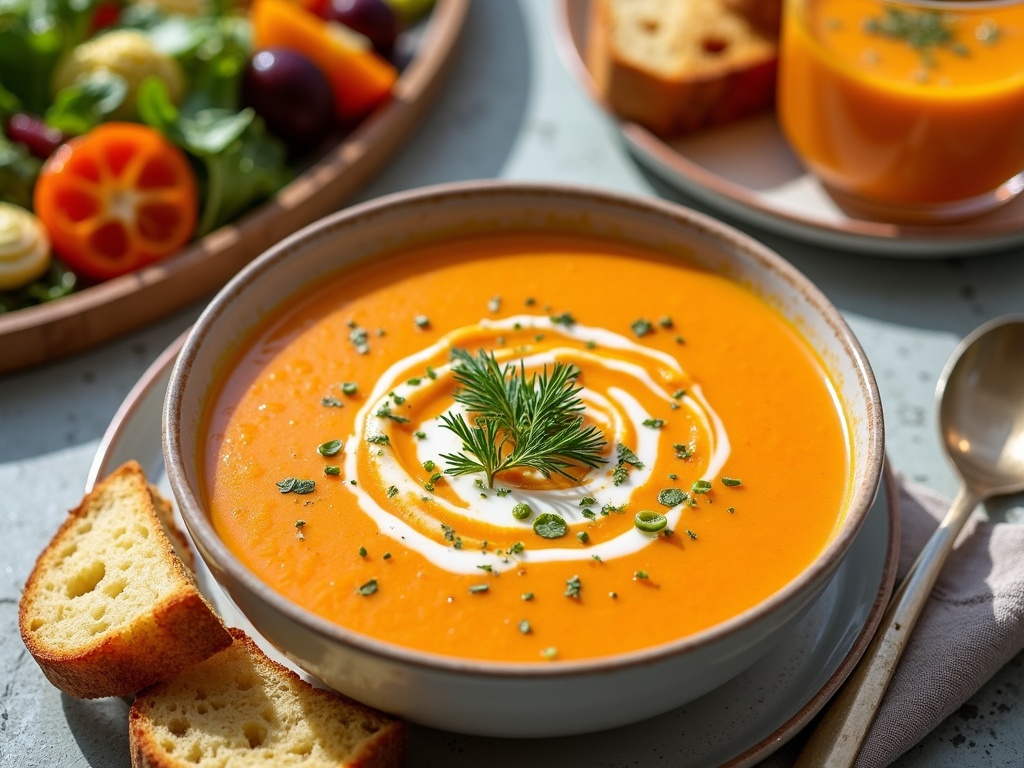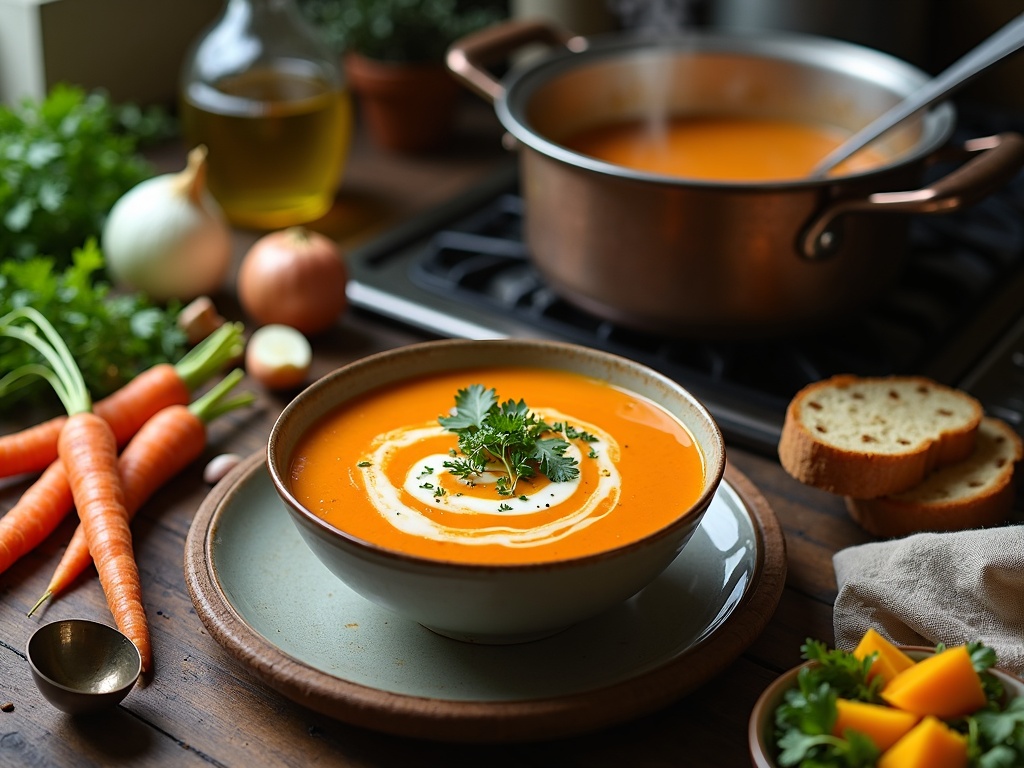Carrot Soup: A Comforting, Nutrient-Rich Classic
Carrot soup turns basic ingredients into a smooth, nutrient-rich comfort food that’s cheap and adaptable in the kitchen.
Find In This Article
Key Takeaways
- Quick and budget-friendly: Carrot soup comes together in under 45 minutes with inexpensive ingredients such as carrots, vegetable broth, onions, garlic, and optional ginger.
- Nutritional value: Packed with beta-carotene, fiber, and vitamins, this soup remains low in calories, making it a nutritional powerhouse.
- Texture tips: For the perfect creamy texture, cut carrots evenly, soften well during cooking, and blend thoroughly after allowing the soup to cool slightly.
- Flavor development: Sautéing vegetables before adding broth and toasting spices boosts depth and complexity in your soup’s flavor.
- Ideal for batch cooking: It stores well in the refrigerator for up to 5 days and can be frozen for up to 3 months, making it perfect for meal prep.
For more inspiration and tips on making carrot soup, visit this easy carrot soup recipe to get started with variations and techniques.
Why You’ll Love This Cozy Soup
I’ve made this carrot soup countless times, and it never fails to delight everyone at my table. The natural sweetness of carrots paired with savory herbs creates a perfect balance that satisfies even the pickiest eaters. What makes this soup special is how it transforms simple ingredients into something truly remarkable without complicated techniques.
Quick, Easy & Affordable
One of the best things about this recipe is how quickly it comes together. You can have this warming soup on the table in under 45 minutes—perfect for busy weeknights when you need something comforting but don’t have hours to spend in the kitchen. Most of that time is hands-off simmering, giving you freedom to prepare the rest of your meal or simply relax.
This soup is incredibly budget-friendly too. Carrots remain one of the most economical vegetables year-round, and you likely already have most other ingredients in your pantry. When I’m watching my grocery budget but still want something nutritious and filling, this healthy carrot recipe always comes to the rescue.
Nutrition Powerhouse
Beyond its delicious taste, this soup packs an impressive nutritional punch. Here’s what makes it so good for you:
- Beta-carotene: Carrots are famous for this antioxidant that supports eye health and immune function
- Fiber: Each serving provides a good amount to keep you satisfied and support digestive health
- Vitamins: Loaded with vitamin A, plus smaller amounts of vitamins C, K and B6
- Low calorie: Filling and satisfying without being heavy
I often pair this carrot soup with a slice of crusty bread or a simple fresh side salad for a complete meal. It’s also wonderful as a starter before a main course when I’m entertaining guests.
The leftovers taste even better the next day as the flavors continue to develop overnight. I often make a double batch specifically to enjoy throughout the week for quick lunches. The soup freezes beautifully too—just portion it into containers for easy grab-and-go meals when you’re short on time.
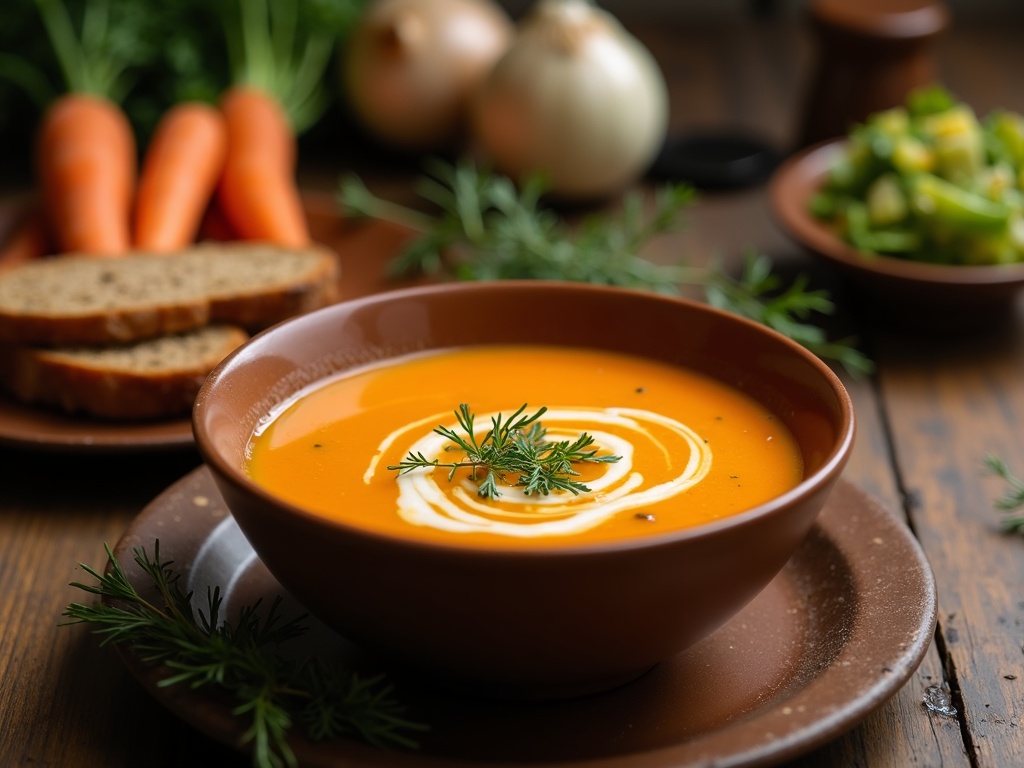
What You’ll Need for This Recipe
I’ve gathered all the essentials to create a truly flavorful and nourishing carrot soup that’s both simple and impressive. This recipe requires minimal ingredients but delivers maximum flavor, making it perfect for weeknight dinners or special occasions when you want to impress your guests without spending hours in the kitchen.
Ingredient List
The beauty of this carrot soup lies in its straightforward ingredient list that focuses on fresh, wholesome components:
- 2 tablespoons olive oil – This forms the flavorful base that helps develop those initial caramelized flavors
- 1 medium onion, chopped – Adds sweetness and depth to the soup
- 4 cups fresh carrots, chopped – The star of our show! Try to find bright orange, firm carrots for the best flavor
- 2 cloves garlic, minced – Provides that aromatic punch that elevates the entire dish
- 4 cups vegetable broth – Creates the perfect consistency while adding depth
- 1 teaspoon fresh ginger, grated – Adds a subtle warmth and complexity that pairs perfectly with carrots
- Salt and pepper to taste – Essential for balancing and enhancing all the flavors
- Optional: heavy cream for garnish – For a luxurious finish if you’re feeling indulgent
The foundation of amazing healthy soup recipes always starts with fresh ingredients. I recommend selecting carrots that are firm and bright orange, as they’ll have the sweetest flavor. If you can find carrots with their tops still attached, that’s often a sign of freshness.
What makes this recipe so approachable is that most of these ingredients are likely already in your kitchen. The olive oil creates a flavorful base for sautéing the onions and garlic, while the vegetable broth adds depth without overpowering the carrot flavor.
Fresh ginger is my secret weapon in this recipe – it adds a subtle warmth that complements the natural sweetness of the carrots beautifully. If you don’t have fresh ginger on hand, you can substitute with ¼ teaspoon of ground ginger, though the fresh variety does provide a brighter flavor.
For those looking to experiment with flavor variations, this soup pairs wonderfully with other root vegetables. You might consider adding a sweet potato to enhance the creamy texture and add nutritional value.
The optional heavy cream garnish transforms this everyday soup into something special. Just a swirl on top creates a beautiful presentation and adds richness to each spoonful. If you’re keeping things dairy-free, coconut cream makes an excellent substitute with a hint of tropical flavor that works surprisingly well with the carrots.
For a complete meal, I like to serve this soup with crusty bread and a side fresh salad for contrast. During summer months, you might even enjoy this soup chilled, similar to a refreshing gazpacho – just thin it slightly with extra broth if needed.
Equipment-wise, you’ll need a large pot for cooking and either an immersion blender or standard blender for pureeing. The immersion blender option saves on cleanup, but either method works perfectly fine.
Step-by-Step Cooking Instructions
Creating a perfect carrot soup starts with the right technique, not just ingredients. I’ve found that following these precise steps elevates a simple soup into something truly special – a vibrant bowl that balances sweetness and savory notes beautifully.
The Cooking Process
First, heat oil in a large pot over medium heat, creating a foundation for developing flavors. I prefer using olive oil for its fruity undertones that complement the natural sweetness of carrots, but any neutral cooking oil works well.
Next, add your chopped onions to the hot oil and sauté until they become translucent, which typically takes about 5-7 minutes. This process releases the onion’s sweetness and builds the first layer of flavor for your delicious homemade soup.
Once your onions have softened, add the chopped carrots and minced garlic to the pot. Cook this mixture for approximately 5 minutes, stirring occasionally to prevent the garlic from burning while allowing the carrots to begin softening.
Now comes the crucial step – pour in your broth and bring everything to a boil. I’ve found that vegetable broth maintains the pure carrot flavor, but chicken broth adds a richer dimension if you’re not making a healthy vegetarian version.
After reaching a boil, reduce the heat to a gentle simmer and let the soup cook for 20-25 minutes. This slow cooking tenderizes the carrots perfectly while allowing the flavors to meld together.
The final transformation happens when you blend the soup. Using an immersion blender directly in the pot creates the smoothest texture with minimal cleanup. If you don’t have one, carefully transfer batches to a standard blender, making sure not to overfill.
Finish your soup by seasoning with salt and pepper to taste. This simple step shouldn’t be rushed – tasting and adjusting brings all the flavors into perfect balance, turning simple ingredients into a vibrant and refreshing dish that can be enjoyed year-round.
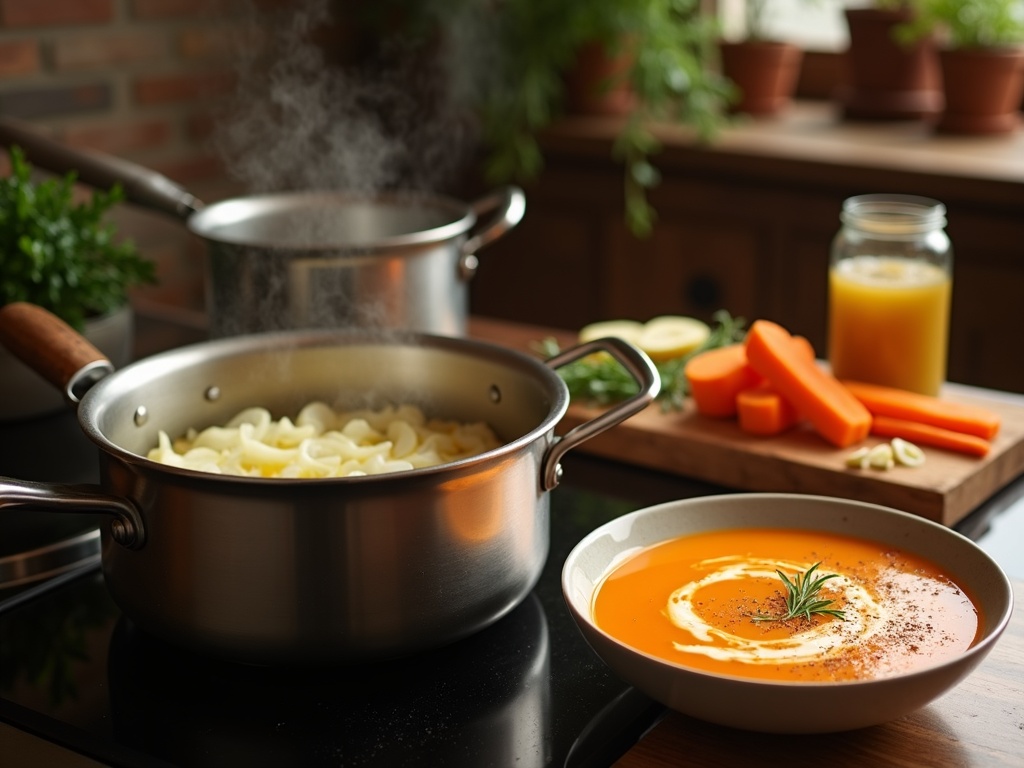
Common Mistakes to Watch Out For
Making carrot soup might seem straightforward, but certain missteps can turn your vibrant, flavorful dish into a disappointing meal. I’ve encountered these issues myself and learned how to avoid them through plenty of trial and error. Knowing what pitfalls to avoid will help you create a perfect carrot soup every time.
Recipe Execution Errors
Not properly softening the carrots is perhaps the most common mistake I see in carrot soup preparation. Hard, undercooked carrots won’t blend smoothly, resulting in a chunky texture rather than the velvety consistency that makes cold soups and hot varieties so comforting. I always make sure to cook my carrots until they’re tender enough to be easily pierced with a fork. This might take 15-20 minutes depending on how they’re cut, but this patience pays off in the final product.
Skipping the sautéing step can significantly impact your soup’s depth of flavor. When you sauté carrots with aromatics like onions and garlic before adding liquid, you’re developing a rich foundation for your soup. This process caramelizes the natural sugars in the vegetables, creating complex flavor compounds that can’t be achieved by simply boiling everything together. I always take at least 5-10 minutes to sauté my vegetables until they’re fragrant and starting to soften.
Using too much liquid is another frequent error. A delicious carrot soup should be creamy and substantial, not watery and thin. I’ve found that adding liquid gradually gives me better control over the final consistency. You can always add more broth or water, but it’s much harder to fix an overly diluted soup. For about 1 pound of carrots, start with just 3-4 cups of liquid and adjust from there based on your desired thickness.
Under-seasoning is the silent killer of many healthy vegetable soups including carrot varieties. Carrots have a natural sweetness that needs balancing with salt and acid to create a well-rounded flavor profile. I typically season at several stages: a pinch of salt while sautéing the vegetables, again after adding the liquid, and a final adjustment before serving. Don’t forget a squeeze of lemon juice or a splash of vinegar at the end to brighten all the flavors.
Other Key Mistakes
- Overseasoning with spices that overpower the carrot flavor
- Rushing the blending process, leaving your soup with lumps
- Forgetting to taste and adjust seasonings before serving
- Not considering texture elements like croutons or seeds as toppings
- Using old, bitter carrots instead of fresh, sweet ones
I’ve noticed that many home cooks also forget the importance of garnishes with carrot soup. A dollop of yogurt, fresh herbs, or a drizzle of roasted vegetable oil can elevate the soup from basic to restaurant-quality. These finishing touches aren’t just visual appeal—they add contrasting flavors and textures that make each spoonful more interesting.
Finally, don’t underestimate the power of proper equipment. While you can make carrot soup with basic kitchen tools, a good blender makes a huge difference in achieving that silky texture. If you’re using an immersion blender, blend longer than you think necessary for the smoothest results.
By avoiding these common pitfalls, your carrot soup will showcase the vegetable’s natural sweetness and vibrant color while delivering a satisfying, comforting meal perfect for any season.
Pro Tips for the Perfect Carrot Soup
Making exceptional carrot soup isn’t just about following a recipe—it’s about mastering techniques that elevate flavor and texture. I’ve discovered several key approaches that transform ordinary carrot soup into something memorable. These professional recommendations can help you create a soup that’s velvety, rich in flavor, and visually stunning.
Selecting and Preparing Your Carrots
Fresh, bright orange carrots form the foundation of an outstanding soup. When shopping, I look for firm carrots with vibrant color—this indicates higher beta-carotene content and sweeter flavor. The greens should appear fresh and feathery if still attached, signaling recently harvested produce. I avoid carrots that feel limp or show any signs of splitting, as these indicators suggest they’re past their prime.
After bringing home those perfect specimens, preparation makes all the difference. Cutting carrots into uniform pieces ensures they cook at the same rate—an often overlooked but critical detail. When pieces vary in size, smaller chunks overcook and dissolve while larger ones remain firm, resulting in inconsistent texture.
For most healthy soup recipes, I aim for pieces approximately ½-inch thick. This size balances quick cooking with optimal flavor development. If you’re short on time, food processors with slicing attachments can create beautifully consistent pieces, but hand-cutting gives you more control over thickness.
Flavor-Boosting Techniques
The difference between good and extraordinary carrot soup often comes down to how you handle spices and execute the final blend. One game-changing technique is toasting your spices before adding any liquid. This simple step activates the essential oils in spices, intensifying their flavors and aromas.
I typically use a dry pan over medium heat for 30–60 seconds, stirring constantly to prevent burning. Common spices that benefit from this treatment include:
- Cumin seeds or powder
- Coriander seeds or powder
- Cardamom pods (lightly crushed)
- Cinnamon sticks or powder
- Fennel seeds
This approach works particularly well with bright, aromatic flavors that complement the natural sweetness of carrots.
When it comes to blending, patience pays dividends. Letting your soup cool slightly before blending serves multiple purposes. First, it’s significantly safer—hot liquid can expand forcefully in blenders, potentially causing burns. Second, slightly cooled soup blends more smoothly, creating that silky texture that marks professional-quality soup.
I’ve found that allowing the soup to cool for about 10 minutes strikes the ideal balance between safety and maintaining enough heat to properly emulsify. When using a standard blender, I fill it only halfway, covering the top with a kitchen towel while blending. Immersion blenders offer greater safety but may require longer blending for comparable smoothness.
For spectacular results, consider this additional trick: after blending, pass the soup through a fine-mesh strainer. This extra step removes any remaining fibrous bits, creating an restaurant-quality soup that feels luxurious on the palate.
These techniques don’t just improve taste—they transform the entire eating experience. By focusing on quality ingredients, consistent preparation, proper spice handling, and thoughtful blending, you’ll create carrot soup that delights with both flavor and texture. The best part? These approaches require little extra time but deliver significantly enhanced results.
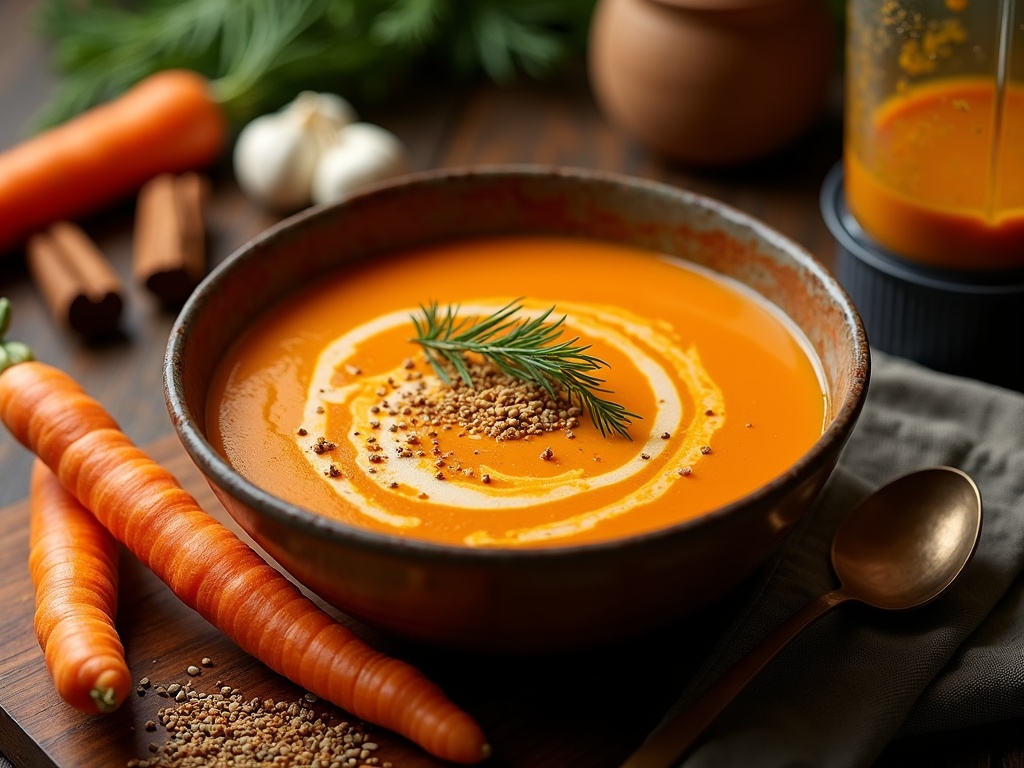
Storing and Reheating
One of the reasons I love making carrot soup recipes is their impressive shelf life. This vibrant orange soup stays fresh in the refrigerator for up to 5 days when stored in an airtight container, making it perfect for meal prep and busy weeknights.
Refrigeration and Freezing Tips
For refrigeration, I recommend cooling the soup completely before transferring it to containers. Glass containers work best as they won’t absorb the color or flavor of the carrots.
The soup is also incredibly freezer-friendly. To freeze:
- Let the soup cool completely before portioning
- Use freezer-safe containers leaving a half-inch of space at the top for expansion
- Label with the date (it stays good for up to 3 months)
- Consider freezing in individual portions for quick lunches
For longer storage, I like to portion my carrot soup into silicone muffin trays before transferring to freezer bags – this creates perfect single-serving portions that thaw quickly.
Perfect Reheating Methods
When it’s time to enjoy your stored soup, gentle reheating is key to maintaining its flavor and texture. I always reach for the stovetop method for the best results. Pour the soup into a saucepan and warm over medium-low heat, stirring occasionally to ensure even heating.
If your carrot soup has thickened during storage (which is perfectly normal), simply add a splash of water or broth to thin it to your preferred consistency. Start with a tablespoon at a time until you reach the right texture.
For those busy days, microwave reheating works too. Just use a microwave-safe container, cover loosely, and heat in 30-second intervals, stirring between each until the soup reaches your desired temperature.
After reheating, I sometimes like to add a fresh garnish like a swirl of cream, fresh herbs, or toasted seeds to perk up the homemade soup and make it taste freshly made again.
Tasty Variations to Try
I’ve experimented with countless carrot soup recipes over the years and discovered that a few simple adjustments can transform this basic dish into something extraordinary. The natural sweetness of carrots provides the perfect canvas for adding complementary flavors that elevate the soup to new heights.
Spice and Creaminess Upgrades
Adding curry powder creates an instant Indian-inspired transformation that works wonderfully with carrots. Just a tablespoon of quality curry powder added during the sautéing process infuses the entire pot with warm, complex flavors. The earthy spices complement the natural sweetness of the carrots perfectly.
For a luxuriously creamy texture without dairy, coconut milk is my go-to addition. Half a can stirred in during the final minutes of cooking creates a silky, rich soup with a subtle tropical note that pairs surprisingly well with the carrots. This combination makes for a satisfying healthy recipe that doesn’t compromise on flavor or texture.
Roasted garlic adds incredible depth to carrot soup. Rather than using raw garlic, I roast a whole bulb until soft and sweet, then squeeze the cloves directly into the soup before blending. The mellow, caramelized flavor complements the natural sweetness of the carrots without overwhelming the soup with harsh garlic notes.
Finishing Touches
Fresh herbs serve as more than just garnish – they add brightness and complexity to each spoonful. A handful of chopped cilantro adds a citrusy note that works particularly well with curry versions, while dill contributes a delicate anise flavor that enhances the natural sweetness of carrots. For a more classic approach, finely chopped parsley or chives sprinkled on top just before serving adds color and a mild onion flavor.
Don’t stop at herbs – consider additional garnishes like:
- A swirl of yogurt
- Toasted pumpkin seeds
- A drizzle of chili oil for heat
These finishing touches add visual appeal and textural contrast to your homemade soup creation.
By playing with these variations, you can enjoy carrot soup several times a month without repeating the exact same flavors. The versatility of this simple vegetable makes it perfect for culinary experimentation while maintaining its nutritional benefits.
Serving Suggestions
Carrot soup is incredibly versatile when it comes to presentation and accompanying sides. I’ve discovered that the right garnishes and pairings can transform this simple dish into something truly special for any occasion.
Garnishes That Elevate
A swirl of cream on top of your carrot soup creates a beautiful visual contrast and adds richness to each spoonful. I prefer using heavy cream or crème fraîche for a luxurious finish, but coconut cream works wonderfully for a dairy-free alternative.
Fresh herbs sprinkled over your soup add both flavor and visual appeal. These herbs complement carrot soup particularly well:
- Finely chopped chives for a mild onion flavor
- Dill fronds for a bright, fresh taste
- Cilantro leaves for a citrusy note
- Thyme leaves for an earthy depth
- Mint for a surprising but delightful contrast
Crunchy homemade croutons provide a satisfying textural element against the smoothness of nutritious carrot soup. I make mine by tossing bread cubes in olive oil, garlic powder, and herbs before toasting until golden brown.
Perfect Pairings
Nothing complements a bowl of carrot soup better than crusty bread served on the side. A slice of sourdough or a chunk of baguette is perfect for dipping and soaking up every last bit of soup. For something more substantial, I sometimes serve grilled cheese sandwiches alongside for a classic soup-and-sandwich combo.
For a complete meal, consider adding a fresh vibrant side salad with a light vinaigrette. The crispness of raw vegetables provides a pleasant contrast to the warm soup. When entertaining, I often serve carrot soup as a starter in small cups, followed by a main course.
During summer months, I like to chill my carrot soup for a refreshing alternative that pairs beautifully with grilled seasonal vegetables. A cold carrot soup with a hint of ginger and orange makes an elegant first course for outdoor dining.
For a protein boost, add a spoonful of Greek yogurt instead of cream, and pair with a quinoa salad or grilled chicken. This combination creates a balanced meal that’s both satisfying and nourishing.
